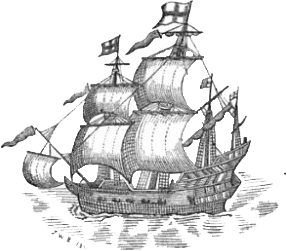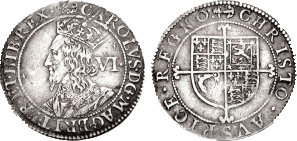While reading up on the economy of colonial America, I finally discovered why the American colonies suffered from a specie or currency shortage. (Something I had always wondered about, but lacked the time to research.) The English government banned the exportation of its sterling coins to the colonies. The Crown prohibited exportation of its coin because in addition to subscribing to the mercantilist idea that colonies should send wealth too their mother country, not vice versa, the English economy experienced periods of inadequate coin. (The Bank of England helped to rectify this problem after its firm establishment in 1715.)
Economic historians attribute the English currency shortage to two causes:
 1. Culturally, the English people valued gold more than silver and as a result English merchants seized every opportunity to trade away silver coins to countries with higher silver exchange rates. Although the trade in silver increased merchants' buying power, it also removed most of the nation's small coin from circulation. This proved to be a major problem. England had plenty of gold coins in circulation, but most English people could only afford to use silver coins. Therefore, the English government banned the exportation of sterling coins to its colonies, in part, because it needed to keep small coins in circulation at home.
1. Culturally, the English people valued gold more than silver and as a result English merchants seized every opportunity to trade away silver coins to countries with higher silver exchange rates. Although the trade in silver increased merchants' buying power, it also removed most of the nation's small coin from circulation. This proved to be a major problem. England had plenty of gold coins in circulation, but most English people could only afford to use silver coins. Therefore, the English government banned the exportation of sterling coins to its colonies, in part, because it needed to keep small coins in circulation at home.
 2. Prior to 1695, the English economy suffered from a debased silver currency. Two kinds of silver coin circulated in the seventeenth-century English marketplace: hammered and milled. English Treasury employees minted hammered coins by hammering the treasury’s official die (usually a depiction of the reigning monarch) into a sheet of silver. As a result, these coins tended to be thin, irregular in shape, and have a good sized blank border around the imprinted design. The English people preferred hammered coins because they could "clip" the metal around the coin's irregular edges anytime they needed to make change; both the coins and their “clippings” served as legal tender. “Clipping” caused the coins to lose weight and therefore their face value. As a result, the English people valued the coins by measured weight, or tale, instead of their minted value.
2. Prior to 1695, the English economy suffered from a debased silver currency. Two kinds of silver coin circulated in the seventeenth-century English marketplace: hammered and milled. English Treasury employees minted hammered coins by hammering the treasury’s official die (usually a depiction of the reigning monarch) into a sheet of silver. As a result, these coins tended to be thin, irregular in shape, and have a good sized blank border around the imprinted design. The English people preferred hammered coins because they could "clip" the metal around the coin's irregular edges anytime they needed to make change; both the coins and their “clippings” served as legal tender. “Clipping” caused the coins to lose weight and therefore their face value. As a result, the English people valued the coins by measured weight, or tale, instead of their minted value.
 The Treasury tried to stop "clipping" by introducing milled coins, which received their design from a mechanical press. Aside from manufacturing thick coins with a high relief design, the press also produced uniformly circular-shaped coins because it cut-off the excess metal around the coin’s design. This mechanized cut left a milled, or reeding, pattern around the coin's exterior edge. The coin’s thickness and its patterned edge prevented people from tampering with the metal content of the coin. As coin "clippings" enabled people to make exact change, the English disliked milled coins because they could not be clipped. Of course, merchants preferred the milled coins for their export trade.
The Treasury tried to stop "clipping" by introducing milled coins, which received their design from a mechanical press. Aside from manufacturing thick coins with a high relief design, the press also produced uniformly circular-shaped coins because it cut-off the excess metal around the coin’s design. This mechanized cut left a milled, or reeding, pattern around the coin's exterior edge. The coin’s thickness and its patterned edge prevented people from tampering with the metal content of the coin. As coin "clippings" enabled people to make exact change, the English disliked milled coins because they could not be clipped. Of course, merchants preferred the milled coins for their export trade.
Until the Crown sorted out its home currency problems, it could not deal with those of its colonial economies.